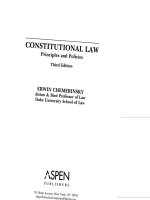Rational expectations and inflation third edition
Bạn đang xem bản rút gọn của tài liệu. Xem và tải ngay bản đầy đủ của tài liệu tại đây (6.27 MB, 407 trang )
Rational Expectations and Inflation
Rational Expectations and Inflation
Third Edition
Thomas J. Sargent
Princeton University Press
Princeton and Oxford
Copyright © 2013 by Princeton University Press
Published by Princeton University Press
41 William Street, Princeton, New Jersey 08540
In the United Kingdom: Princeton University Press
6 Oxford Street, Woodstock, Oxfordshire, OX20 1TW
All Rights Reserved
Library of Congress Control Number: 2013930076
ISBN 978-0-691-15870-9
British Library Cataloging-in-Publication Data is available
This book has been composed in LATEX using Peter Wilson’s memoir class
The publisher would like to acknowledge the author of this volume for
providing the camera-ready copy from which this book was printed.
Printed on acid-free paper. ∞ press.princeton.edu
Printed in the United States of America
10 9 8 7 6 5 4 3 2 1
For Anne, Addison, and Ari
Contents
LIST OF FIGURES
LIST OF TABLES
ACKNOWLEDGEMENTS
PREFACE TO THE THIRD EDITION
xi
xiii
xv
xvii
PREFACE TO THE SECOND EDITION
xix
PREFACE TO THE FIRST EDITION
xxi
1. RATIONAL EXPECTATIONS AND THE RECONSTRUCTION OF MACROECONOMICS
Behavior Changes with the Rules of the Game
The Investment Decision
Are Government Deficits Inflationary?
General Implications of the Examples
New Econometric Methods
Historical and Cross-Country Analysis
Implications for Policymakers
2. REAGANOMICS AND CREDIBILITY
Dynamic Games
An Economy as a Dynamic Game
Are Government Deficits Inflationary?
Reaganomics and Credibility
Conclusion
3. THE ENDS OF FOUR BIG INFLATIONS
1
1
10
11
13
15
17
19
21
26
33
36
38
Introduction
The Gold Standard
Austria
Hungary
Poland
Germany
Czechoslovakia
Conclusion
Appendix
4. STOPPING MODERATE INFLATIONS: THE METHODS OF POINCARÉ AND THATCHER
Introduction
The “Poincaré Miracle”
The British Experience
Mrs. Thatcher’s Plan
The Outcome of the Plan So Far
Overshooting the £M3 Target
The Government Deficit
North Sea Oil and the Pound Sterling
Conclusion
Second Thoughts
Poincaré and Moreau
Methods of Thatcher and Reagan
Where to Play Chicken
38
42
47
53
58
60
64
66
67
111
111
116
123
124
129
130
132
136
142
143
145
146
5. SOME UNPLEASANT MONETARIST ARITHMETIC
with Neil Wallace
162
Introduction
A Simple Monetarist Model
The Cagan-Bresciani-Turroni Effect
Conclusions and Qualifications
Appendix 1
162
166
171
173
177
Appendix 2
Appendix 3 by Danny Quah
180
193
6. INTERPRETING THE REAGAN DEFICITS
197
Government Budget Balance
Barro Tax Smoothing
Wallace’s Game of Chicken
Conclusion
Appendix
Hall’s Model
197
199
204
207
208
Barro’s Model
7. SPECULATIONS ABOUT THE SPECULATION AGAINST THE HONG KONG DOLLAR
with David T. Beers and Neil Wallace
A Look at Hong Kong’s Monetary System
The Official Float Policy
An Indeterminate Exchange Rate?
A Timely Depreciation
Hong Kong’s Other Options
Epilogue
8. SIX ESSAYS IN PERSUASION
Back to Basics on Budgets
Confrontations over Deficits
An Open Letter to the Brazilian Finance Minister
Letter to Another Brazilian Finance Minister
The Economics Are Simple
211
212
214
215
218
222
223
228
228
231
233
237
Credibility
A Delicate Institutional Issue
Advice
Reasonable Doubt about the Real Plan
An American History Lesson for Europe
241
245
9. MACROECONOMIC FEATURES OF THE FRENCH REVOLUTION
248
with François R. Velde
Introduction
Chronology of Events
248
Before the Revolution
Even Absolute Monarchies Have Budget Constraints
251
Macroeconomic Theories Coloring Our Observations
The British Experience
Across the Channel
French Fiscal Backwardness or Optimality?
Snapshot of the Old Regime Laws
Offices
Taxes
Apology for the Old Regime
Fiscal Pressures to Reform
Sentiment for Copying Britain
A Temptation Resisted
Sustainability or Bad Choices?
The Last Fiscal Crisis of the Old Regime
The Search for a New Order
Annus Mirabilis (1789)
267
Some Adverse and Persistent Revenue Shocks
Designing a New Tax System
Birth of a Currency
Rise and Fall of the Assignat
A Real-Bills Regime (1790–92)
War
Terror (1793–94)
Legal Restrictions
Hyperinflation (1795–96)
274
The Government’s Response
Default
The Legacy
Unintended Consequences for England through Specie Flows
Appendix: The Auction Mechanism
10. UNITED STATES THEN, EUROPE NOW
Introduction
The Math
Need for More Economic Theory?
292
294
297
297
300
A Humbling Message?
Modeling Reforms
The United States
Victorious but in Default
307
Trade Policies
Crisis and a Second Revolution
Restructuring Fiscal Institutions
The Order of Fiscal and Monetary Reorganizations
310
Fiscal Policy
Discrimination and Liquidity
Federal Bailout of States
Why Pay?
Monetary Arrangements
A National Bank?
A Mint
Outcomes
Following Through?
Federal and State Paper Monies?
319
What Kind of Fiscal Union?
323
What Kind of Currency Union?
Another Federal Bailout of the States?
Lessons for Now?
328
Appendix: Outcomes in Graphs
Data Sources
331
REFERENCES
AUTHOR INDEX
SUBJECT INDEX
339
357
361
List of Figures
3.1
3.2
3.3
3.4
3.5
3.6
Retail prices in Austria, 1921–24
Wholesale prices in Hungary, 1921–24
Wholesale prices in Poland, 1921–24
Wholesale prices in Germany, 1919–24
Inflation path with a fully anticipated decrease in money supply
growth
Inflation path with a previously unexpected decrease in money
growth
41
42
43
44
69
70
4.1
Gross domestic fixed capital formation
136
5.1
5.2
The equilibrium law of motion of the inflation rate
The equilibrium dynamics of inflation.
182
183
9.1
9.2
9.3
9.4
9.5
9.6
9.7
Ratio of debt service to taxes, Britain and France, 1688–1788
Revenues and spending in Britain, 1689–1790
Revenues and spending in France, 1759–88
Military spending in Britain and France, 1688–1789
Index of real per capita revenues in France, 1726–1845
Assignats used for debt reimbursement and total issue, 1790–92
Scatter plot of the logarithm of the inflation rate versus real
balances of assignats
Real balances of assignats
Price level and price of gold
Prices in Paris of foreign exchange futures, January 1789–July
1793
Spending and revenues, 1791–95
Seigniorage raised on the assignat
Price in Paris of Hamburg currency delivered in Hamburg, March
1795–September 1796
Price of a 5 F perpetual, 1795–1802
252
253
256
263
270
275
277
9.8
9.9
9.10
9.11
9.12
9.13
9.14
278
279
281
284
286
288
292
9.15 Price of a 5 F perpetual, September–December 1799
293
10.1 Composition of federal revenues by source
10.2 Composition of federal expenditures by type
10.3 Per capita composition of federal revenues by source
10.4 Per capita composition of federal expenditures by type
10.5 Primary deficit-to-GDP ratio
10.6 Par value debt-to-GDP ratio
10.7 Annual inflation and real GDP growth
10.8 Composition of the debt outstanding by type of obligation
10.9 Per capita real GDP (2005 dollars)
10.10Per capita nominal GDP
334
334
335
335
336
336
337
337
338
338
List of Tables
3.1
3.2
3.3
3.4
3.5
3.6
3.7
3.8
3.9
3.10
3.11
3.12
3.13
3.14
3.15
3.16
3.17
3.18
3.19
3.20
3.21
3.22
70
71
72
73
73
74
75
75
76
80
81
82
82
83
89
90
91
92
94
95
96
106
3.23
3.24
3.25
3.26
3.27
Austrian Budgets, 1919–22
Total Note Circulation of Austrian Crowns
Austrian Retail Prices, 1921–24
Exchange Rates, Austrian Crowns
The Austrian Budget, 1923–25
Austrian National Bank Balance Sheet
Number Of Austrian Unemployed in Receipt of Relief
Hungarian Budget Estimates, 1920–24
Balance Sheet of Hungarian Central Bank or State Note Institute
Hungarian Price and Exchange Rate
Hungarian Budget, 1924–25
Number of Unemployed in Hungary
Polish Receipts and Expenditures
Balance Sheet of Bank of Poland, 1918–25
Polish Index Numbers of Wholesale Prices, 1921–25
Polish Exchange Rates, 1919–25
Polish Unemployed
German Wholesale Prices, 1914–24
German Exchange Rates, 1914–25
Real German Revenues and Expenditures
Balance Sheet of German Reichsbank, 1921–24
Ordinary Revenues and Expenditures of the German Federal
Government
Index of Physical Volume of Production per Capita in Germany
Czechoslovakia, Receipts and Expenditures 1919–25
Note Issue of Banking Office of Czechoslovakia, 1919–24
Czechoslovakian Exchange Rates, 1919–24
Czechoslovakian Wholesale Prices, 1922–24
4.1
French Wholesale Price Index
147
106
107
108
109
110
4.2
4.3
Dollar Exchange in Paris
GDP at Factor Cost and Final Expenditures on Goods and Services
at Market Prices
4.4 Exchange, Price, and Balance
4.5 Output and Unemployment
4.6 Gross Domestic Fixed Capital Formation by Sector
4.7 Money Supply in the United Kingdom
4.8 General Government Receipts and Expenditure
4.9 Financial Transactions of the Public Sector
4.10 Net Purchases or Sales of Government Debt, by Maturity
4.11 Calculated Redemption Yields of Government Bonds
4.12 Interest Rates, Security Prices, and Yields
147
148
5.1
5.2
5.3
5.4
Price Level and Real Balance Dynamics
Behavior of the System Before and After T
Two Economies
Different θ s
174
188
190
192
7.1
7.2
7.3
The Exchange Fund’s Balance Sheet
Balance Sheet Effects of Issuing HK$ 100
How an Exchange Rate Depreciation Can Help a Financial Firm
213
215
220
9.1
State of Debt in 1789
262
150
151
152
153
155
157
159
160
161
Acknowledgements
I would like to thank the following publishers for granting permission
to reprint articles included in this book: “Rational Expectations and
the Reconstruction of Macroeconomics,” originally published in the
Federal Reserve Bank of Minneapolis Quarterly Review, Summer 1980;
“Reaganomics and Credibility,” originally published in Monetary
Policy, MIT Press, edited by Albert Ando et al., 1985. Reprinted with
permission of the MIT Press. “The Ends of Four Big Hyperinflation,”
originally published in Inflation, edited by Robert E. Hall and
published by the University of Chicago Press for the National Bureau
of Economic Research in 1983; “Stopping Moderate Inflations: The
Methods of Poincaré and Thatcher,” originally published in Inflation,
Debt and Indexation, MIT Press, edited by Rudiger Dornbusch, 1983.
Reprinted with permission of the MIT Press. “Unpleasant Monetarist
Arithmetic,” written with Neil Wallace, and originally published in
the Federal Reserve Bank of Minneapolis Quarterly Review, Fall 1981;
“Speculating about the Speculation Against the Hong Kong Dollar,”
written with David Beers and Neil Wallace, and originally published
in the Federal Reserve Bank of Minneapolis Quarterly Review, Fall 1983;
“Interpreting the Reagan Deficits,” originally published in the Federal
Reserve Bank of San Francisco Review, Fall 1986; “Back to Basics on
Budgets,” published in the New York Times on August 10, 1983;
“Confrontations Over Deficits,” published in the New York Times on
August 12, 1983; “An Open Letter to the Brazilian Finance Minister,”
published in the Wall Street Journal on January 30, 1986; “Letter to
Another Brazilian Finance Minister,” published in the Banco de
Investimentos Garantia S.A. Newsletter, November 1993; “Reasonable
Doubt about the Real Plan,” published in the Banco de Investimentos
Garantia S.A. Newsletter, December 19, 1995; “An American History
Lesson for Europe,” Wall Street Journal, February 3, 2012;
“Macroeconomic Features of the French Revolution,” coauthored with
François Velde, from the Journal of Political Economy in 1995. Chapter
10 is “US Then, Europe Now,” published earlier by the Nobel
Foundation and the Journal of Political Economy in 2012.
I would like to thank my friends David Beers, François Velde, and
Neil Wallace for giving me permission to reprint papers that we coauthored. I thank François Velde for having crafted LATEX programs
that typeset this book and for his generosity and patience in helping
me solve many typesetting problems.
Preface to the Third Edition
I have added new material to this edition. Chapter 9 is
“Macroeconomic Features of the French Revolution,” co-authored
with François Velde, from the Journal of Political Economy in 1995.
Chapter 10 is “United States Then, Europe Now,” published earlier by
the Nobel Foundation and the Journal of Political Economy in 2012. I
have also added three essays in persuasion to chapter 8, two from the
Banco de Investimentos Garantia S.A. Newsletter and one from the Wall
Street Journal.
Milton Friedman taught that governments confront unavoidable
problems only after they become crises. “Macroeconomic Features of
the French Revolution” and “United States Then, Europe Now”
illustrate that principle. In the 1780s, governments in France and the
United States had made promises about taxes and expenditures that
couldn’t be honored so long as decisions continued to be made under
existing constitutions. Political revolutions in France and the United
States replaced old constitutions with new ones designed better to
serve interests of particular groups of citizens. Those 1789 political
revolutions confronted perennial questions about government debt:
1. Should a government pay its debts? When a government pays
its debts, different groups of people reap benefits or suffer
costs. Whether a government chooses to pay always depends on
a balance of interests and a distribution of political power.
2. In a federal or confederal system, should a central government
pay debts incurred by subordinate governments? When a
central government bails out a subordinate government, it
rewards taxpayers and creditors of the subordinate government.
That fosters adverse incentives for a subordinate government to
be profligate again. To prevent that, a central government that
bails out a subordinate government often requires the
subordinate government to surrender fiscal sovereignty.
3. Should government debt be risk-free or should it be ex ante
state-contingent and therefore risky? Theories of dynamic
optimal taxation say that governments should issue statecontingent debt (e.g., Lucas and Stokey (1983)). Nevertheless,
today most governments issue debt that promises to provide a
risk-free nominal return. Creditors care about real returns that
are heavily influenced by inflation rates. Inflation allows
governments and other issuers of risk-free nominal debt de
facto to issue risky real debt.
Chapter 7 about Hong Kong in 1983 gives an example in which a
government, purposefully or not, used inflation to repair balance
sheets of imperiled financial intermediaries. That is one way a central
bank can magically convert “bad loans into good ones.” Pressures
exist for central banks to do that today both in Europe and the United
States.
Thomas J. Sargent
New York, New York
September 2012
Preface to the Second Edition
I have used the occasion of a reprinting to add two chapters to this
book. Chapter 6 reprints the article “Interpreting the Reagan
Deficits,” which I published in the Federal Reserve Bank of San
Francisco Review in 1986. Chapter 8 reprints three “essays in
persuasion” that were published in the New York Times and the Wall
Street Journal.
Aside from correcting a few grammatical and typographical errors,
I have not altered the original articles. However, in response to
comments by John Taylor and Joseph Bisignano, I have added a few
remarks at the end of Chapter 4, confessing errors that I made in
comparing and interpreting the monetary and fiscal policies of
Poincaré and Thatcher. Because of fundamental and enduring changes
in fiscal policy that Thatcher engineered at about the time that I
wrote chapter 4, the appropriate contrast is not between Thatcher’s
policies and Poincaré’s, but between Thatcher’s and Reagan’s.
In recent years, there has been much good research on subjects
treated in this book. About the experiences of countries that have
stopped or attempted to stop big inflations, systematic work has been
done by Bomberger and Makinen (1980, 1983), and Siklos (1989,
1993), who have assembled interesting additional data bearing on the
interpretation of inflation in terms of the “monetarist arithmetic”
emphasized in this book. On the German hyperinflation, see
Holtfrerich (1980), Webb (1989), and Garber (1982). Garber’s paper
is noteworthy for the real distortions associated with the German
hyperinflation that he documents, and on the basis of which he warns
the reader against interpreting big inflations as purely “neutral”
monetary phenomena. Also see the paper on the Hapsburg successor
states by Wicker (1986). For useful critical summaries of the
literature, see Dornbusch et al. (1990) and Bruno (1989). A number
of papers have been written extending and modifying our
“Unpleasant Monetarist Arithmetic.” Examples include papers by
Drazen (1985) and Liviatan (1984).
The articles in this book are nontechnical attempts to put rational
expectations methods to work to interpret macroeconomic events at
an informal level. Some of the arguments in this book now seem to
me to be too simplistic, and would require modification if they were
to be recast in modern technical terms. This is especially true of the
passages in chapters 1, 2, and 3 in which I discuss “policy regimes.” I
compare two ways of making and analyzing public policy choices:
taking “isolated actions” versus setting “rules” to be applied
recurrently in the future. An up-to-date treatment of this matter
would focus on issues of commitment and the timing of decisions and
how they depend upon the presence or absence of institutions or
reputational mechanisms that might give a current government the
ability to tie the hands of its successors. If a government is operating
in an environment where some such commitment mechanism is in
place, then it can, should, and (under some theories) will choose a
“policy regime” once and for all, with future governments simply
administering a set of rules they have been handed. However, where
such a commitment mechanism is not in place, it is more natural to
model the government as choosing sequentially, doing the best it can
period-by-period. In the last five years, macroeconomists have made
important strides in clarifying these issues by borrowing and adapting
concepts from game theory. See Stokey (1989) and Chari and Kehoe
(1990).
This book uses historical evidence at many points. I am neither an
historian nor an economic historian, and have relied entirely on
secondary sources. In writing these articles, I am not pretending to be
an historian, only a macroeconomist interested in giving my theories
a shot at some interesting data sets that others have taken the time to
assemble.
Thomas J. Sargent
Chicago, Illinois
February 1992
Preface to the First Edition
During the last decade, the idea of rational expectations transformed
macroeconomic theory. A simple intuition motivates this idea;
namely, that people do not systematically ignore readily available
information that could be used to improve their decisions. However,
the initial applications of this idea in macroeconomic theory and
econometrics have been technically demanding. The highly technical
nature of this early work is not surprising, since this work itself grew
out of the technical literatures on optimally controlling Keynesian
macroeconometric models and on deriving optimal decision rules for
the Keynesian categories of consumption, investment, and money
demand. One consequence of the highly technical orientation of early
work on rational expectations in macroeconomics is that an
appreciation has been slow to develop for the relevance of the ideas
for the practice of day-to-day macroeconomics. Rational expectations
macroeconomics reasons with a new set of concepts and a new
language. It is not simply proposing new answers to old questions but
a new view about which questions are useful to ask. During the long
period of dominance of Keynesian macroeconomic theory, there
developed a broad body of practical experience in applying the theory
quickly in informal contexts. Such experience created ease of
application and communication, which were important ingredients in
the practical success of Keynesian economics as an applied theory.
One of the (legitimate) reasons for resistance to rational expectations
ideas in macroeconomics has been that they are perceived as
destroying the old language and tools of applied macroeconomics
while providing no workable substitute.
My main reason for writing this book was to try my hand at
putting rational expectations macroeconomics to work at an informal,
noneconometric level in order to describe and interpret some recent
and historical economic events. The events studied mainly involve
periods of actual or threatened depreciation in the value of a
country’s currency and in which a government was interested in
preventing that depreciation. To interpret these events, I have used a
rational expectations theory of inflation. Besides being a phenomenon
of great contemporary interest, the process of inflation has long been
thought to be influenced by people’s methods of forming expectations
about inflation. Thus, the study of inflation provides a natural context
for trying to apply rational expectations theories.
Two main ideas run throughout the text. The first is the principle
of strategic interdependence, which holds that one person’s pattern of
behavior depends on the behavior patterns of those forming his
environment. When behavior patterns of those forming a person’s
environment change, the individual can usually profit by adjusting his
or her own behavior pattern. This principle, which is at the heart of
rational expectations theory, was ignored under standard practice in
Keynesian macroeconomics. One of the purposes of this text is to
pursue the logical implications of this principle and to apply it
repeatedly in interpreting a variety of episodes.
The second idea is that monetary and fiscal policies must be
coordinated because the government faces a budget constraint. It
follows that there is no “purely monetary” cure for inflation, if purely
monetary means a policy that can be imposed by the central bank
without any assistance from the taxing and spending authorities. This
idea will guide our interpretation of the causes of the beginnings and
endings of inflationary episodes.
The first chapter, “Rational Expectations and the Reconstruction of
Macroeconomics,” is an overview that describes some key ideas of
rational expectations macroeconomics. This chapter describes in
greater detail the role of informal historical studies relative to formal
econometric ones. The second chapter, “Reaganomics and
Credibility,” elaborates the principle of strategic interdependence and
applies it to interpret the struggle between monetary and fiscal policy
that has occurred in the United States since 1981.
The next two chapters, “The Ends of Four Big Inflations” and
“Stopping Moderate Inflations: The Methods of Poincaré and
Thatcher,” provide interpretations of economic policies and outcomes
during several periods when rapid inflation was either occurring or
thought to be threatening to occur. The chapter “Some Unpleasant
Monetarist Arithmetic,” written with Neil Wallace, explores some
aspects of the coordination problem facing the monetary and fiscal
authority. The unpleasant arithmetic alluded to in the title prevents
the central bank from successfully fighting inflation by itself if the
fiscal authority persists in running a net-of-interest budget deficit. The
analytics of the monetary-fiscal coordination problem that are laid
out in this chapter are used extensively in the other chapters.
The chapter “Speculations about the Speculation against the Hong
Kong Dollar” was written with David Beers and Neil Wallace. It
describes some recent events in Hong Kong involving the depreciation
of the Hong Kong dollar. We think of the situation as one in which
Hong Kong banks, being confronted with a situation in which many
of their loans were threatening to go bad, found these bad loans
turned into good ones when the central bank acted to depreciate the
currency in which the loans and the banks’ deposits were
denominated. It requires only a little imagination to see the situation
in Hong Kong as a microcosm of the international debt crisis. A
depreciation of the US dollar via inflation would go a long way
toward “making good loans out of bad ones” in the countries now on
the verge of technical default.
Thomas J. Sargent
Minneapolis, Minnesota
March 1985
1
Rational Expectations and the
Reconstruction of Macroeconomics
The government has strategies. The people have counterstrategies.
Ancient Chinese proverb
Behavior Changes with the Rules of the Game
In order to provide quantitative advice about the effects of alternative
economic policies, economists have constructed collections of
equations known as econometric models.1 For the most part these
models consist of equations that attempt to describe the behavior of
economic agents—firms, consumers, and governments—in terms of
variables that are assumed to be closely related to their situations.
Such equations are often called decision rules because they describe
the decisions people make about things like consumption rates,
investment rates, and portfolios as functions of variables that
summarize the information people use to make those decisions. For
all of their mathematical sophistication, econometric models amount
to statistical devices for organizing and detecting patterns in the past
behavior of people’s decision making, patterns that can then be used
as a basis for predicting their future behavior.
As devices for extrapolating future behavior from the past under a
given set of rules of the game, or government policies, these models
appear to have performed well.2 They have not performed well,
however, when the rules changed. In formulating advice for
policymakers, economists have routinely used these models to predict
the consequences of historically unprecedented, hypothetical









